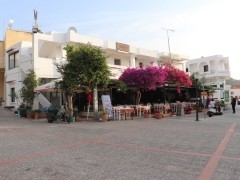Pyli - Kos Island
Pili

Pyli is one of the oldest villages on the Greek island of Kos. It is located in the central part of the island's mainland, about 16 km southwest of the main town of Kos. The village of Pyli is known for its traditional atmosphere, historical monuments and the friendliness of the locals.
The village of Pyli as a tourist centre on the island of Kos
Pyli is a picturesque village located in the interior of the island of Kos, surrounded by lush greenery and olive groves. It is one of the smaller resorts on Kos and retains its original character. It is often overlooked by tourists when choosing their holidays, which is reflected in the smaller accommodation options, but the village has a lot to offer.
The village of Pyli still retains the atmosphere of an old Greek village with stone houses, an old café and small tavernas surrounding the local Platía square. There are several tavernas and restaurants offering both traditional Greek food and international dishes. Accommodation in Pyli is limited, mostly in the form of small family-run guesthouses or apartments.
As it is an inland village, Pyli does not have its own adjacent beach. However, the nearest coastline is easily accessible from here, and locals and tourists staying in Pyli most often head to Marmari, 4 km away, and its beautiful, long and well-organised sandy beaches of Marmari and Limnaria.
The village of Pyli itself is divided into two parts - Kato Pili ("Lower Pili"), which is situated on still relatively flat ground, and Áno Pili ("Upper Pili"), which extends already to the foot of Mount Dikeos.
History, monuments and cultural heritage of Pyli
The village of Pyli has roots dating back to the Middle Ages, when the inhabitants moved to safer areas inland due to pirate raids. The present village was probably founded sometime between the 15th and 17th centuries, but the surrounding area was inhabited earlier, as evidenced by the burial chamber of King Charmyl, which dates back to the Hellenistic period (4th century BC).
The tomb of King Charmyl is one of the important historical monuments in the area. It is an ancient burial chamber, carved into the rock and with a characteristic entrance with a massive stone portal. Inside the tomb there are niches that were used to store the remains. According to legend, the local ruler Charmylas, associated with the island's ancient history, was buried here. The site is freely accessible and is a popular destination for visitors wishing to discover the lesser-known archaeological sites of Kos. The tomb is also an interesting stop on the way to other attractions in the area, such as the ruins of Old Pyli.
One of the main attractions of Pyli is the historic "old town" of Paleo Pili, a now abandoned village with the remains of a Byzantine fortified town and a Byzantine castle. The old village of Paleo Pyli was built around the 11th century on a hill to serve as a fortified settlement protecting the inhabitants from enemy raids. Its dominant feature, a Byzantine fortress, was later enlarged by the Venetians in the 14th century. Paleo Pili is located on a hill above the village, at the foot of the Dikeos Mountains, and offers spectacular views of the surrounding countryside in addition to the opportunity to explore the ancient ruins.
In the village of Pyli, we also recommend visiting Pyliotiko Spiti ("Traditional House"), an old peasant house with three rooms, where the kitchen, living room and bedroom have been preserved with the original furniture and trinkets as the owners left them more than 100 years ago. Nearby is the Pigi Fountain with a spring of cold water flowing from 6 fountains in the shape of lions' heads. And just a few metres away is the church of Agios Nikolaos, after which the locals call the upper part of the village. There are several beautiful churches in Pyli, another one being the church of Agios Georgios.
Pili is a very cultural town and there are many celebrations and festivals throughout the year. In February, the famous Pyli Carnival takes place, and on St. George's Day (Agios Georgios) the locals organise the "panighyri" festival with horse racing. In June, the festival in honour of St. John Klidonas (Agios Ioannis Klidonas) takes place and during August the municipality organises several cultural events in order to attract as many tourists as possible.
For whom Pyli is suitable
Pyli is an ideal starting point for hiking and cycling, thanks to its location in the heart of the island. Its peaceful surroundings and authentic atmosphere attract especially lovers of history, nature and Greek culture. The village is suitable for couples, singles and seniors who want to experience something different from the busy beach resorts and discover the real soul of Kos.
More touristic destinations of Kos
Close resorts: Marmari
Most favourite resorts of Kos: Kardamena, Kefalos, Lambi, Marmari, Mastichari, Kos Town, Tigaki
Resorts, beaches, sights or trips - clearly listed on the map of Kos.
Did you visit this place and do you have some additional informations, interessting observation or photos?

























